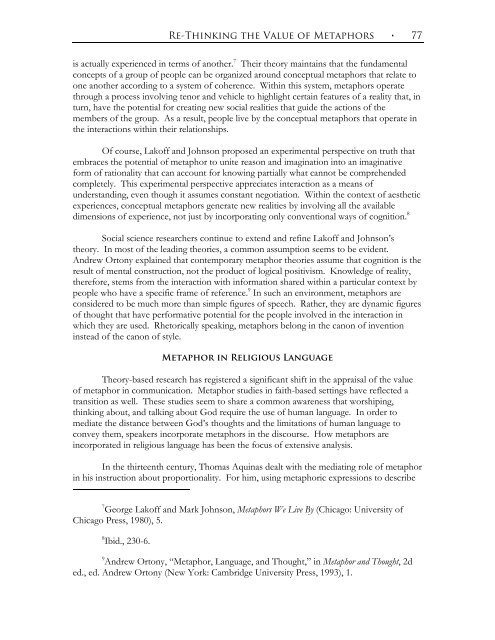0 jbtm vol. 6, no. 2 the proclamation of the gospel - Baptist Center for ...
0 jbtm vol. 6, no. 2 the proclamation of the gospel - Baptist Center for ...
0 jbtm vol. 6, no. 2 the proclamation of the gospel - Baptist Center for ...
You also want an ePaper? Increase the reach of your titles
YUMPU automatically turns print PDFs into web optimized ePapers that Google loves.
Re-Thinking <strong>the</strong> Value <strong>of</strong> Metaphors ٠ 77<br />
is actually experienced in terms <strong>of</strong> a<strong>no</strong><strong>the</strong>r. 7 Their <strong>the</strong>ory maintains that <strong>the</strong> fundamental<br />
concepts <strong>of</strong> a group <strong>of</strong> people can be organized around conceptual metaphors that relate to<br />
one a<strong>no</strong><strong>the</strong>r according to a system <strong>of</strong> coherence. Within this system, metaphors operate<br />
through a process in<strong>vol</strong>ving te<strong>no</strong>r and vehicle to highlight certain features <strong>of</strong> a reality that, in<br />
turn, have <strong>the</strong> potential <strong>for</strong> creating new social realities that guide <strong>the</strong> actions <strong>of</strong> <strong>the</strong><br />
members <strong>of</strong> <strong>the</strong> group. As a result, people live by <strong>the</strong> conceptual metaphors that operate in<br />
<strong>the</strong> interactions within <strong>the</strong>ir relationships.<br />
Of course, Lak<strong>of</strong>f and Johnson proposed an experimental perspective on truth that<br />
embraces <strong>the</strong> potential <strong>of</strong> metaphor to unite reason and imagination into an imaginative<br />
<strong>for</strong>m <strong>of</strong> rationality that can account <strong>for</strong> k<strong>no</strong>wing partially what can<strong>no</strong>t be comprehended<br />
completely. This experimental perspective appreciates interaction as a means <strong>of</strong><br />
understanding, even though it assumes constant negotiation. Within <strong>the</strong> context <strong>of</strong> aes<strong>the</strong>tic<br />
experiences, conceptual metaphors generate new realities by in<strong>vol</strong>ving all <strong>the</strong> available<br />
dimensions <strong>of</strong> experience, <strong>no</strong>t just by incorporating only conventional ways <strong>of</strong> cognition. 8<br />
Social science researchers continue to extend and refine Lak<strong>of</strong>f and Johnson’s<br />
<strong>the</strong>ory. In most <strong>of</strong> <strong>the</strong> leading <strong>the</strong>ories, a common assumption seems to be evident.<br />
Andrew Ortony explained that contemporary metaphor <strong>the</strong>ories assume that cognition is <strong>the</strong><br />
result <strong>of</strong> mental construction, <strong>no</strong>t <strong>the</strong> product <strong>of</strong> logical positivism. K<strong>no</strong>wledge <strong>of</strong> reality,<br />
<strong>the</strong>re<strong>for</strong>e, stems from <strong>the</strong> interaction with in<strong>for</strong>mation shared within a particular context by<br />
people who have a specific frame <strong>of</strong> reference. 9 In such an environment, metaphors are<br />
considered to be much more than simple figures <strong>of</strong> speech. Ra<strong>the</strong>r, <strong>the</strong>y are dynamic figures<br />
<strong>of</strong> thought that have per<strong>for</strong>mative potential <strong>for</strong> <strong>the</strong> people in<strong>vol</strong>ved in <strong>the</strong> interaction in<br />
which <strong>the</strong>y are used. Rhetorically speaking, metaphors belong in <strong>the</strong> ca<strong>no</strong>n <strong>of</strong> invention<br />
instead <strong>of</strong> <strong>the</strong> ca<strong>no</strong>n <strong>of</strong> style.<br />
Metaphor in Religious Language<br />
Theory-based research has registered a significant shift in <strong>the</strong> appraisal <strong>of</strong> <strong>the</strong> value<br />
<strong>of</strong> metaphor in communication. Metaphor studies in faith-based settings have reflected a<br />
transition as well. These studies seem to share a common awareness that worshiping,<br />
thinking about, and talking about God require <strong>the</strong> use <strong>of</strong> human language. In order to<br />
mediate <strong>the</strong> distance between God’s thoughts and <strong>the</strong> limitations <strong>of</strong> human language to<br />
convey <strong>the</strong>m, speakers incorporate metaphors in <strong>the</strong> discourse. How metaphors are<br />
incorporated in religious language has been <strong>the</strong> focus <strong>of</strong> extensive analysis.<br />
In <strong>the</strong> thirteenth century, Thomas Aquinas dealt with <strong>the</strong> mediating role <strong>of</strong> metaphor<br />
in his instruction about proportionality. For him, using metaphoric expressions to describe<br />
7 George Lak<strong>of</strong>f and Mark Johnson, Metaphors We Live By (Chicago: University <strong>of</strong><br />
Chicago Press, 1980), 5.<br />
8 Ibid., 230-6.<br />
9 Andrew Ortony, “Metaphor, Language, and Thought,” in Metaphor and Thought, 2d<br />
ed., ed. Andrew Ortony (New York: Cambridge University Press, 1993), 1.


